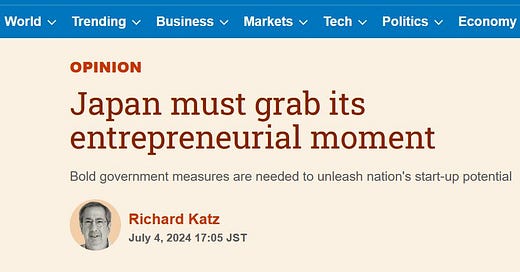My Nikkei Oped On Boosting Entrepreneurship
What Tokyo Could Do That Would Make a Big Difference
All sorts of societal, economic, and technological changes are boosting entrepreneurship in Japan. However, unless these trends are amplified by government policy, they will never reach the critical mass needed to boost overall growth. So far, Tokyo is offering mostly rhetoric. In this opinion piece in Nikkei Asia, I discuss a few of the measures that could help turn rhetoric into reality. In a previous post, I discussed the political pressures that could induce Tokyo to genuinely promote entrepreneurship and the snowball effect this could catalyze.
If you already subscribe—or are willing to pay $1 for a one-month subscription— click here. Otherwise, you can read it here with Nikkei Asia’s kind permission:
The below article is adapted from Katz's new book, "The Contest for Japan's Economic Future: Entrepreneurs vs. Corporate Giants"
Generational and technological change are giving Japan its greatest opportunity for a genuine economic recovery in decades. If they reach critical mass, they could help resurrect the kind of entrepreneurial effervescence that propelled the high-growth era. Countries with more entrepreneurship grow faster as new companies bring fresh ideas. Unfortunately, since the 1990s, various impediments have prevented Japan from generating as many high-growth small and medium-size enterprises (SMEs) as other rich countries.
The good news is that positive trends are now giving birth to a larger number of successful, innovative startups of all sizes, not just those destined for the stock market. However, unless these trends are amplified by government policy, they will never reach critical mass. So far, unfortunately, Tokyo is offering mostly rhetoric. To turn rhetoric into reality, Tokyo could start with measures that have a small political or budgetary cost but can catalyze enough improvement to attract support for further measures.
Historically, SMEs with high growth potential have faced great difficulty recruiting workers, especially veterans with technical and management skills. The lifetime employment system made it too risky to leave a secure job to join a startup, most of which fail. The risk is ending up in low-paid, non-regular work. Fortunately, the best and the brightest of today's adults in their 20s and 30s are more willing to take that risk because they know their skills are in demand. Unlike 10 or 15 years ago, graduates of Tokyo, Waseda, Keio, and other top universities rank among the founders. One of Japan's newest billionaires founded a web platform matching skilled employees looking to upgrade jobs with employers looking for mid-career hires.
To expand labor mobility further, the government needs to reduce the risk. The first step is to practice the kind of "active labor measures" used elsewhere. This includes worker retraining and better help in finding new jobs for the unemployed. By reducing long-term unemployment, these measures improve labor mobility. Out of 23 rich countries, Japan comes in 20th in the share of gross domestic product spent on active measures -- at just 0.15%. Instead, Japan pays moribund companies to retain workers they no longer need. Tokyo also needs to make all non-regulars eligible for unemployment insurance. Most importantly, it needs to enforce existing laws mandating equal pay for equal work between regulars and non-regulars.
The traditional distribution system has long made it difficult for new companies, especially those challenging incumbents, to access customers. Technology, via e-commerce, has created a workaround. In 2023 on Rakuten alone, 57,000 SMEs enjoyed sales of 5.7 trillion yen (about $35 billion) to tens of millions of customers. Meanwhile, big companies that lack digital skills have been compelled to partner with startups that have mastered them. Toyota now has more software companies as first-tier suppliers than hardware parts makers, and these software companies retain their independence.
Still, the majority of potentially high-growth SMEs find themselves strapped for the sales revenue needed to fund investments in future growth. For decades, the national, prefectural and local governments allotted as much as half of their procurement budget for SMEs, even the zombies among them. This procurement equals about 16% of GDP. Only in 2015 did Tokyo finally set aside some procurement for new companies under 10 years old, a measly 1% of national-level procurement.
In 2018, it raised the goal to 3%, but has yet to come close. In 2022, the administration of Prime Minister Fumio Kishida said the latest result was just 78 billion yen -- just 0.8% of procurement and a tiny 0.014% of GDP. It promised a five-year plan to reach the 3% goal. It remains to be seen whether a bill to be implemented beginning next year will give innovative young SMEs the initial boost they need to put them on the high-growth track.
The biggest remaining obstacle is lack of access to outside funding. Japan lacks enough "angel" investors to provide "seed money" to SMEs. Moreover, far more than banks elsewhere, Japanese banks hesitate to lend to newer firms. The banks rely on collateral rather than profit projections and newer companies lack that collateral. Moreover, banks regularly charge 10-year-old firms a significantly higher interest rate than 50-year-old companies. Without enough outside finance, few SMEs can become large companies.
Japan could adopt financial measures that have promoted entrepreneurship elsewhere. One is financial aid to research and development. Ninety-two percent of Japan's support for R&D goes to large companies. That's because the aid comes in the form of tax credits that only profitable firms can use. Startups take years to become profitable, and Japan lacks the "tax carry forward credit" that other countries use to solve this problem. The "carry forward" enables them to use the credit once they do become profitable.
Secondly, while Kishida introduced an "angel tax break" for individuals to invest in startups, they have to invest in an individual company, which is far riskier than the stock market. It won't work. By contrast, France's highly successful angel tax break had taxpayers investing in angel funds, which are like mutual funds in the stock market and are even more profitable..
These are just a few of the many possibilities. The Ministry of Finance contends that the budget deficit means Japan cannot afford such measures. On the contrary, Japan cannot afford not to make such investments. Without them, Japan cannot boost GDP growth and thus the tax base.
What a shame if Japan were to miss this opportunity.
___________________________
BTW, I’ll be speaking July 11th via web on financial reform in Japan. For details and to register, see https://www.piie.com/events/2024/structural-changes-and-policy-developments-japanese-financial-system
On some days on amazon.co.jp





